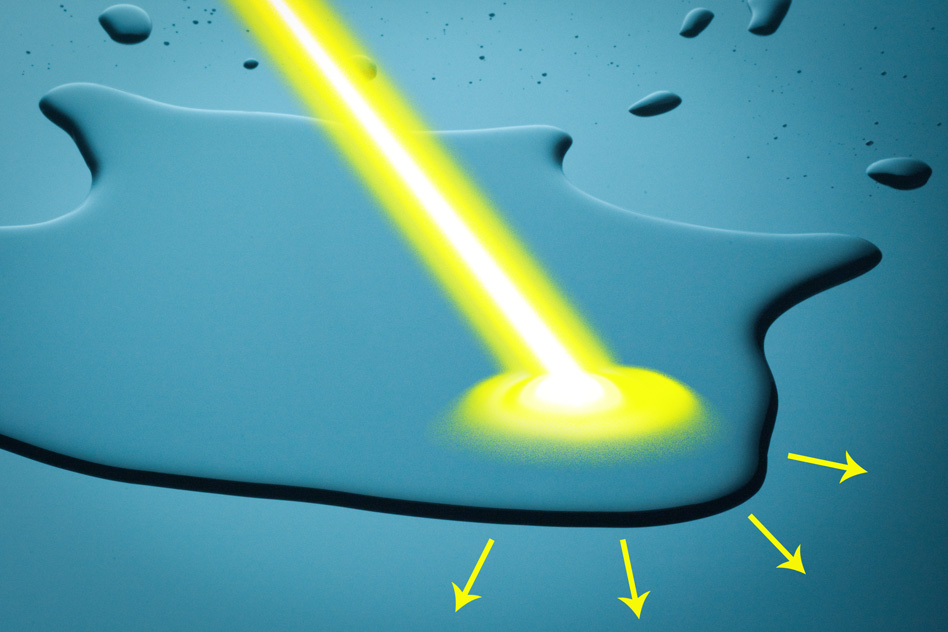Researchers at MIT have developed a way to control how water moves over a surface, using light. The technique, described in Nature Communications, could lead to technologies such as microfluidic diagnostic devices whose channels and valves could be reprogrammed in real time, or systems that could separate water from oil on drilling rigs, the researchers claim.

A new system developed by MIT engineers could make it possible to control the way water moves over a surface, using only light. Credit: Jose-Luis Olivares/MIT
The new surfaces were created using titanium dioxide, also known as titania, an active ingredient in most sunscreens. The researchers took a film of polymer-bound titania particles on a glass surface and dip-coated it with a simple organic dye, making it highly responsive to the visible spectrum. When exposed to sunlight, the surface would undergo a significant increase in its wettability – the way it interacts with fluids.
‘We were inspired by the work in photovoltaics, where dye sensitisation was used to improve the efficiency of absorption of solar radiation,’ said Kripa Varansi, associate professor of mechanical engineering at MIT and an author of the Nature Communications paper. ‘The coupling of the dye to titania particles allows for the generation of charge carriers upon light illumination. This creates an electric potential difference to be established between the surface and the liquid upon illumination, and leads to a change in the wetting properties.’
By selectively changing the material’s wettability using a moving beam of light, the researchers were able to direct droplets of water around the surface towards more wettable areas with great precision. This enabled them to directly separate oil from water by causing individual droplets to coalesce and spread across the surface. ‘Saline water spreads out on our surface under illumination, but oil doesn’t,’ explained another author of the paper, Gibum Kwon. ‘We found that virtually all the seawater will spread out on the surface and get separated from crude oil, under visible light.’ The surfaces could therefore be used to treat frothy mixtures of briny water and crude oil that are often found in oil wells. This has previously been done using electrostatic methods, however these are energy intensive and don’t work if the water is highly saline, as is often the case.
The switchable wettability of the new surfaces also enables them to be self-cleaning, as when the material properties are switched from hydrophilic to hydrophobic, any water on the surface gets driven off, carrying with it any contaminants that might be present. The researchers explained that the new surfaces could be used, for example, to produce a microfluidic diagnostic lab-on-a-chip, where a blood sample could be moved and controlled entirely though the pattern of illumination projected on to it.
The photoresponsivity of the new surfaces is highly tuneable due to the thousands of available organic dyes that they can be treated with. ‘By systematically studying the relationship between the energy levels of the dye and the wettability of the contacting liquid, we have come up with a framework for the design of these light-guided liquid manipulation systems,’ commented Varanasi. ‘By choosing the right kind of dye, we can create a significant change in droplet dynamics.’ The researchers expressed that the physical materials involved in making the surfaces are all widely available, and that the processes to make them are also commonplace.
In similar work published in Physical Review Fluids towards the end of last year, another group of MIT researchers developed a similar way of driving fluid droplets across surfaces using precise changes in temperature. By turning heaters and coolers on and off, the researchers were able to adjust the surface tension across the droplets, which caused them to move across surfaces towards areas of higher surface tension. This method, similar to the manipulation of droplets using light, was said to open up new possibilities in highly adaptable self-cleaning surfaces and microfluidic devices, such as those used in biomedical or chemical testing. The researchers also expressed that the process could be used in de-icing applications in aerospace and other industries, or in the development of highly efficient condensers.

